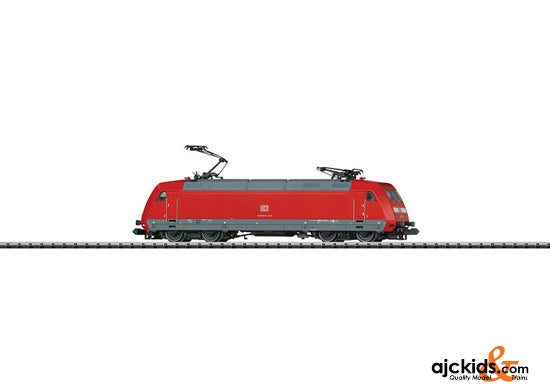Trix 16081 - Dgtl DB AG cl 101 Electric Locomotive
Prototype: German Railroad, Inc. (DB AG) express locomotive, road number 101 113-9. The locomotive looks as it currently does in real life.
Model: The locomotive is new tooling. The locomotive frame and body are constructed of metal. The locomotive has a built-in digital decoder and sound generator for operation with the formats DCC, Selectrix, and Selectrix 2. It also has a motor with a flywheel. 4 axles powered. Traction tires. The headlights and marker lights change over with the direction of travel. Warm white LEDs are used for the lighting. The headlights, marker lights, and cab lighting can be controlled digitally. The locomotive has NEM coupler pockets.
Length over the buffers 119 mm / 4-11/16".
Highlights: New tooling. Metal body. Many sound and control functions. Warm white LEDs for lighting.
T16081 – Class 101 Electric Locomotive In September of 1994, ABB Henschel presented its new locomotive concept "Eco 2000" whose main components had been tested since 1992. The essential new features were the following: dispensing with relay technology, flexi-float trucks with single wheel set control that particularly saved on track wear and an integrated drive system, an "integrated locomotive bus" that saved wiring. Other new features were the MICAS-S processor-controlled guidance system for locomotive control and diagnosis as well as a modular superstructure tailored to the customer and based on tested subassemblies. In November of 1994, the DB ordered the replacement for the class 103 in EC/IC/IR service, 145 four-axle units capable of 220 km/h / 137 mph from the "Eco 2000" family with the new designation 101. Their locomotive bodies were done in sturdy welded steel construction consisting of sheet metal plates and shapes. The three roof hoods including the ventilation grills in the pitch of the roof are removable. Two flexi-float trucks with relatively short wheelbases of 2,650 mm / 104-5/16 inches and low, non-sprung weight provide marvelous running characteristics even on sharp curves. A built-in total drive system (IGA) powers each wheel set. This system includes a three-phase asynchronous traction motor, a gearbox, and the internal ventilated disk brakes, all of it forming a unit. A universal hollow shaft transmits the torque between the gearbox and the wheel set. Speed measurement with radar ensures along with the electronic slip and skid control of the single wheel set control consistent optimal running at maximum adhesion. The main components for the high tension current are the main transformer, at 13 metric tons the heaviest ever used in a DB locomotive, as well as the power converter with the GTO thyristors. The running and brake control are done with the existing MICAS-S guidance system with a 16-bit processor, the entire system being doubled for safety reasons. The DAVIS diagnosis system connected to it ensures the highest level of availability and reduces maintenance costs too. From July 1, 1996 to June 18, 1999 ADtranz delivered (after its takeover of ABB Henschel) road numbers 101 101-145 that are still to be seen exclusively pulling IC and EC trains. Now and then, they may even pull a freight train. With its 6,400 kilowatts / 8,582 horsepower the 101 represents a real all round workhorse. Its smooth boxy body is admirably suited for the application of advertising overlays. Several units are thereby always functioning as mobile advertising mediums and they brighten up the red-white monotony on the German railroad somewhat.
EAN/UPC: 4028106160813



